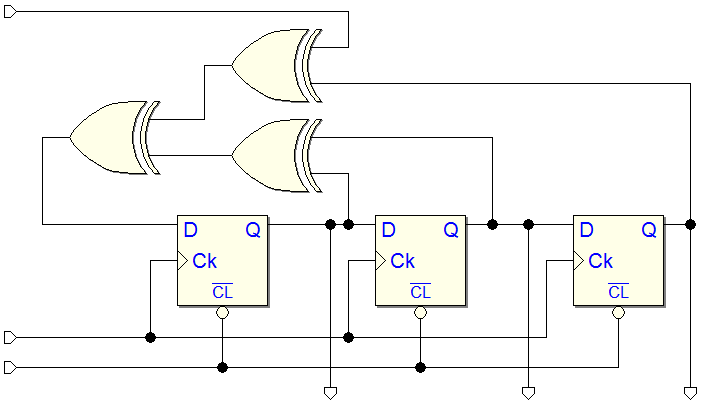![]() Deeds-DcS (Editor)
Deeds-DcS (Editor)
![]() Now, the last path used is also saved in the dialog for the selection of a MSF component (see the next figure). After the reopening, the Dialog will point to the last directory where you opened a FSM component.
Now, the last path used is also saved in the dialog for the selection of a MSF component (see the next figure). After the reopening, the Dialog will point to the last directory where you opened a FSM component.

![]() It was reported that, leaving unconnected the input D of a D-PET flip-flop, on its output appeared an anomalous "Z" value, instead of a simply (and correct) "unknown": the problem has been corrected (as visible in the next figure).
It was reported that, leaving unconnected the input D of a D-PET flip-flop, on its output appeared an anomalous "Z" value, instead of a simply (and correct) "unknown": the problem has been corrected (as visible in the next figure).

![]() In the Text Box Properties Dialog, scroll bars were missing in the string editor. Now a vertical scroll bar was added, as in the next figure. Horizontally, long text lines are always visible because automatic word wrapping is active.
In the Text Box Properties Dialog, scroll bars were missing in the string editor. Now a vertical scroll bar was added, as in the next figure. Horizontally, long text lines are always visible because automatic word wrapping is active.

![]() Fixed a bug regarding the JK-PET flip-flop. In the absence of initialization, and when J = '1' and K = 'Unknown', the flip-flop Q output was changing from 'Unknown' to '1', instead of remaining at 'Unknown' (as it does, after fixing the bug). The bug concerned also the specular case (when K = '1' and J = 'Unknown', with the output going from 'Unknown' to '0').
Fixed a bug regarding the JK-PET flip-flop. In the absence of initialization, and when J = '1' and K = 'Unknown', the flip-flop Q output was changing from 'Unknown' to '1', instead of remaining at 'Unknown' (as it does, after fixing the bug). The bug concerned also the specular case (when K = '1' and J = 'Unknown', with the output going from 'Unknown' to '0').
![]() Fixed the problem of the (annoying) warning messages on starting of simulation (both in animation that in timing mode). These messages were formally correct (due to the presence of unknown values in the initial phase), but perfectly useless and, mainly, source of confusion for the user. There is now a minimum threshold of time (100 nS): below which no warning message is generated.
Fixed the problem of the (annoying) warning messages on starting of simulation (both in animation that in timing mode). These messages were formally correct (due to the presence of unknown values in the initial phase), but perfectly useless and, mainly, source of confusion for the user. There is now a minimum threshold of time (100 nS): below which no warning message is generated.
![]() Now the Time Display, on the Status Bar, depends on the time resolution at the current scale. The number is approximated (rounded) according to the time interval corresponding to one pixels.
Now the Time Display, on the Status Bar, depends on the time resolution at the current scale. The number is approximated (rounded) according to the time interval corresponding to one pixels.

![]() Fixed a bug concerning the assembler: now the second byte of the "RLC B" instruction is regularly generated.
Fixed a bug concerning the assembler: now the second byte of the "RLC B" instruction is regularly generated.
![]()
![]()
![]() Fixed a bug, regarding the positioning of the windows, that occurred when changing from a high resolution desktop screen to a video projector (usually at a lower resolution). The vertical size of the windows was reduced to zero. Now both the vertical and horizontal dimensions, previously saved, are checked and eventually reduced, limiting their size to the screen workspace.
Fixed a bug, regarding the positioning of the windows, that occurred when changing from a high resolution desktop screen to a video projector (usually at a lower resolution). The vertical size of the windows was reduced to zero. Now both the vertical and horizontal dimensions, previously saved, are checked and eventually reduced, limiting their size to the screen workspace.
